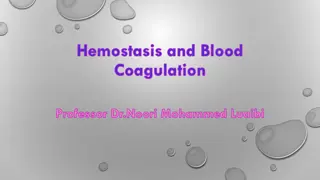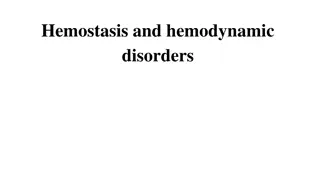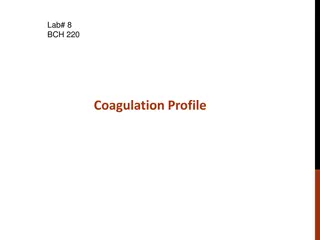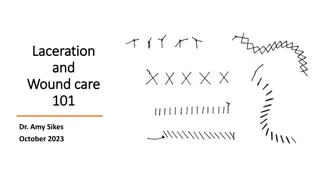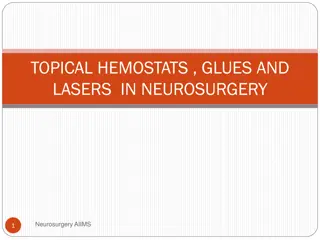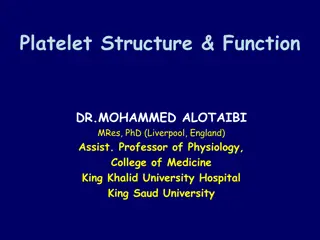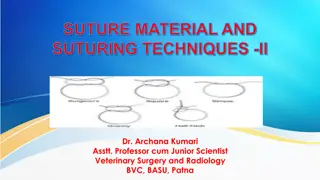Understanding Coagulation Profile in Hemostasis
Coagulation profile testing is crucial in assessing blood clotting ability. The process of coagulation is essential for hemostasis to prevent bleeding or clotting disorders. This summary explores the steps involved in hemostasis, the clotting cascade, and the triggers for the extrinsic and intrinsic
6 views • 14 slides
Understanding Blood Groups, Clotting Time, and Bleeding Time in Medical Practice
This informative material delves into the significance of determining blood groups, clotting time, and bleeding time in medical settings. From explaining the ABO and Rhesus systems to outlining the practical objectives and procedures for the assessments, this resource aims to enhance understanding o
0 views • 34 slides
Hemostasis and Blood Coagulation Mechanisms Explained
Hemostasis refers to the prevention of blood loss through vascular constriction, platelet plug formation, blood clotting, and fibrous tissue growth. Vascular constriction occurs immediately after vessel damage, initiated by myogenic spasm, autacoid factors, and nervous reflexes. Platelet plug format
0 views • 25 slides
Understanding Hemostasis: Key Concepts in Blood Clotting Mechanisms
Hemostasis, crucial for preventing blood loss, involves platelet formation, clotting factors, and fibrinolysis. This process includes vessel constriction, platelet activation, clot formation, and fibrin breakdown. Platelets, produced in the bone marrow, play a vital role in maintaining vascular inte
0 views • 33 slides
Understanding Hemostasis and Hemodynamic Disorders in Health
Hemostasis is crucial for maintaining the health of cells and tissues by ensuring continuous circulation of water, oxygen, and nutrients while removing metabolic waste products. Factors controlling normal hemostasis include the integrity of blood vessel walls, blood content, platelet function, and l
0 views • 14 slides
Understanding Coagulation Profile: A Comprehensive Overview
Coagulation is a crucial process in hemostasis that involves clot formation. This profile delves into estimating clotting time, bleeding time, and prothrombin time to assess coagulation status. Explore the mechanisms of hemostasis, clotting cascade, triggers of intrinsic and extrinsic pathways, and
0 views • 12 slides
Essential Wound Care and Laceration Repair Guidelines
This presentation highlights comprehensive wound evaluation, when to suture or refer for evaluation, wounds not suitable for suturing, and wounds healthcare providers should be able to manage. It covers the goals of laceration repair, tools for wound repair, and the importance of achieving hemostasi
0 views • 18 slides
Advancements in Neurosurgical Instrumentation and Techniques
Thermal energy for hemostasis has a rich history dating back to ancient Egypt, evolving through fire drills, Bovie and Cushing's methods, and the introduction of lasers. Various electrical waveforms are used in neurosurgery, each with specific heating effects. Electrical energy ranging from 250,000
0 views • 55 slides
Topical Hemostats, Glues, and Lasers in Neurosurgery at AIIMS
Hemostasis is crucial in neurosurgery for controlling bleeding without ligatures. Various topical hemostats like chemical, mechanical, collagen, thrombin, and fibrin glues are used. Surgicel and Oxycel, oxidized cellulose polymers, act as physical matrices aiding in clot formation. Gelatin sponges l
0 views • 22 slides
Red Cell Teaching Cases: Anemia Evaluation and Differential Diagnosis
Course Directors Breakfast session at ASH 2012 highlighting various aspects of red cell disorders, including case discussions, laboratory findings, and clinical considerations. Case 1 involves a 35-year-old woman presenting with anemia symptoms, requiring detailed evaluation and management. The sess
0 views • 70 slides
Understanding Platelet Structure and Function in Physiology
Platelets play a crucial role in hemostasis and bleeding disorders. This lecture by Dr. Mohammed Alotaibi covers the ultrastructure of platelets, functions of organelles and surface receptors, mechanisms of platelet functions, and the relationship of membrane receptors and granule content in normal
0 views • 47 slides
Suture Materials and Techniques in Veterinary Surgery: Insights and Guidelines
In this comprehensive guide by Dr. Archana Kumari, explore the goals, characteristics, and armamentarium of suturing, along with suture materials, principles, techniques, and surgical knot considerations. Discover the objectives and qualities of an ideal suture material, as well as the physical stru
0 views • 13 slides
Understanding Surgical Suture Materials and Techniques
Surgical sutures play a crucial role in wound repair by providing support and hemostasis to healing tissue. An ideal suture should meet specific criteria for handling, reaction in tissue, bacterial growth inhibition, knot security, and more. Factors like suture size, flexibility, and surface charact
0 views • 24 slides
Understanding High-Frequency Surgery: Applications and Effects
High-frequency (HF) surgery involves the application of electrical energy to induce thermal changes in tissue cells, used for hemostasis, cutting, and sealing in various surgical procedures. The technique prevents undesirable bioelectrical and biothermal effects like the electrolytic and faradic eff
0 views • 25 slides
Understanding the Clotting Cascade and Hemostasis
The clotting cascade is a complex process involving intrinsic and extrinsic pathways that converge to form fibrin, leading to clot formation. Hemostasis is initiated mainly through the extrinsic pathway in vivo, activating factors that generate thrombin and ultimately convert fibrinogen into insolub
0 views • 11 slides


